Your STL overhangs fail because gravity pulls down molten filament faster than it can solidify when angles exceed 45 degrees. You’re dealing with insufficient cooling that can’t solidify plastic quickly enough, creating sagging and layer collapse. Your print speed might be too fast, or you’re over-extruding material that overwhelms each layer’s ability to maintain shape. Temperature control issues prolong material malleability, while inadequate layer adhesion weakens structural integrity. Understanding these mechanics will transform your printing success.
Understanding the Physics of Overhang Failures
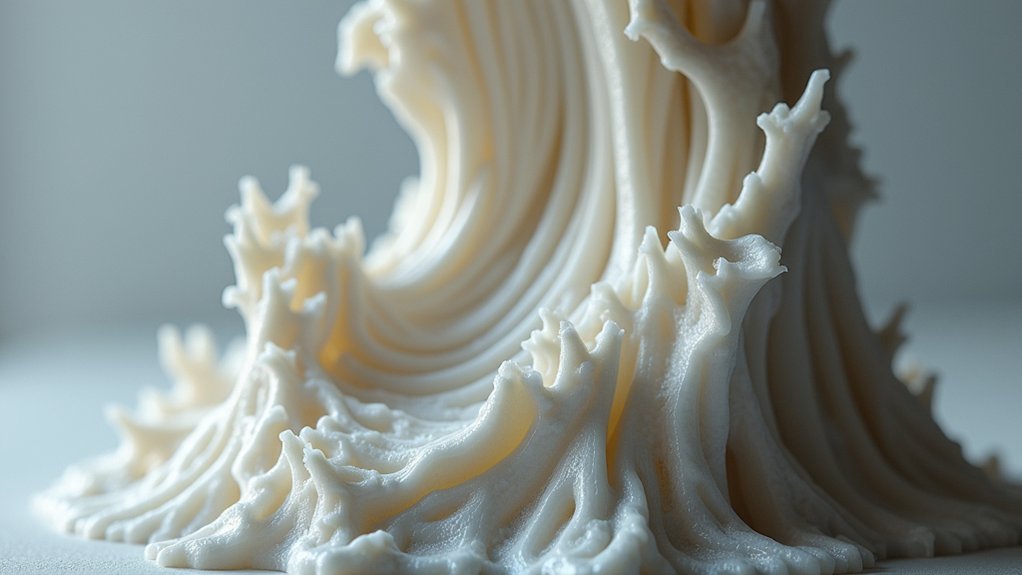
When your 3D printer attempts to create overhangs beyond 45 degrees, gravity becomes your primary enemy, pulling down unsupported filament layers before they can properly solidify.
The 45-degree rule exists because angles steeper than this create insufficient contact area between successive layers, causing structural weakness and inevitable drooping.
Your filament’s material properties directly impact overhang success. Higher viscosity materials flow differently, affecting how well they’ll bridge gaps without support.
Flow rate also determines whether the extruded plastic maintains its intended shape or sags under gravitational force.
Insufficient cooling compounds these physics-based challenges. When filament doesn’t cool quickly enough, it remains pliable longer, making it susceptible to deformation.
This results in stringy appearances, curling, or complete layer collapse, preventing proper printing of your intended overhang geometry.
Critical Angle Limitations and the 45-Degree Rule
You’ll encounter the infamous 45-degree rule when printing overhangs—this critical threshold determines whether your layers can bridge successfully or collapse under gravity’s pull.
Beyond this angle, the physics work against you as each new layer struggles to adhere properly without adequate support from the layer below.
Understanding how gravity battles layer adhesion at these steep angles helps you predict when your print will fail and why certain orientations simply won’t work.
Understanding 45-Degree Threshold
Although 3D printing technology has advanced greatly, the fundamental physics of gravity and material properties still impose critical limitations on overhang angles.
You’ll find that the 45-degree threshold represents the critical point where successful printing shifts to failure-prone territory. Beyond this angle, your filament can’t solidify adequately between layers, leading to drooping and curling issues.
Understanding this threshold helps you optimize your designs:
- Angles ≤ 45 degrees – Your overhangs will print successfully without support structures
- Gravity impact – Minimal effect on filament placement at acceptable angles
- Layer adhesion – Proper bonding occurs when you stay within the threshold
- Printing speed adjustments – Slower speeds can improve overhang quality near the limit
You can enhance results through cooling optimization, but exceeding 45 degrees still requires careful consideration.
Critical Angle Physics
Physics governs every aspect of overhang behavior in 3D printing, with the critical angle representing the precise point where gravitational forces overcome your printer’s ability to maintain structural integrity.
The 45-degree rule isn’t arbitrary—it’s based on how molten filament behaves when extruded. Beyond this threshold, gravity pulls on the material faster than it can solidify and bond to previous layers.
When you exceed 45 degrees, you’re fighting physics itself. The filament lacks sufficient underlying support, causing drooping, sagging, or complete collapse.
While optimized print settings like reduced temperature, increased cooling, and slower speeds can push these limitations, the fundamental physics remain unchanged.
Understanding these critical angle constraints helps you design models with gradual slopes or implement strategic support structures for successful overhangs.
Gravity Vs Layer Adhesion
Layer adhesion becomes your primary battleground when printing overhangs, as it must resist gravity’s relentless downward pull on each newly deposited layer.
When you’re printing angles beyond 45 degrees, gravity’s force exceeds your filament’s adhesive strength, causing inevitable failure.
Understanding this critical relationship helps you identify why overhangs collapse:
- Insufficient contact area – Steeper angles reduce the bonding surface between layers
- Increased gravitational stress – Downward force intensifies as overhang angle increases beyond 45 degrees
- Weakened layer adhesion – Heat from previous layers can’t properly bond with inadequately supported material
- Cumulative failure effect – Each compromised layer compounds the problem, leading to catastrophic drooping
You’ll need support structures or modified print settings when layer adhesion can’t overcome gravity’s demands on your overhangs.
Insufficient Cooling and Temperature Control Issues
When your 3D printer’s cooling system can’t keep up with the demands of overhang printing, the filament stays soft too long and begins to sag or droop before it can properly solidify.
This becomes especially problematic when printing angles exceeding 45 degrees, where gravity works against layer adhesion.
You’ll need to increase your fan speed to 100% during overhang sections to guarantee rapid cooling. High print temperatures worsen this issue by extending the time your filament remains malleable.
Consider reducing your nozzle temperature by 5-10°C when printing overhangs – this allows the material to harden quickly and adhere better to previous layers.
Insufficient part cooling also causes pillowing and stringing, compromising your print’s overall surface quality and structural integrity.
Layer Adhesion Problems in Unsupported Sections
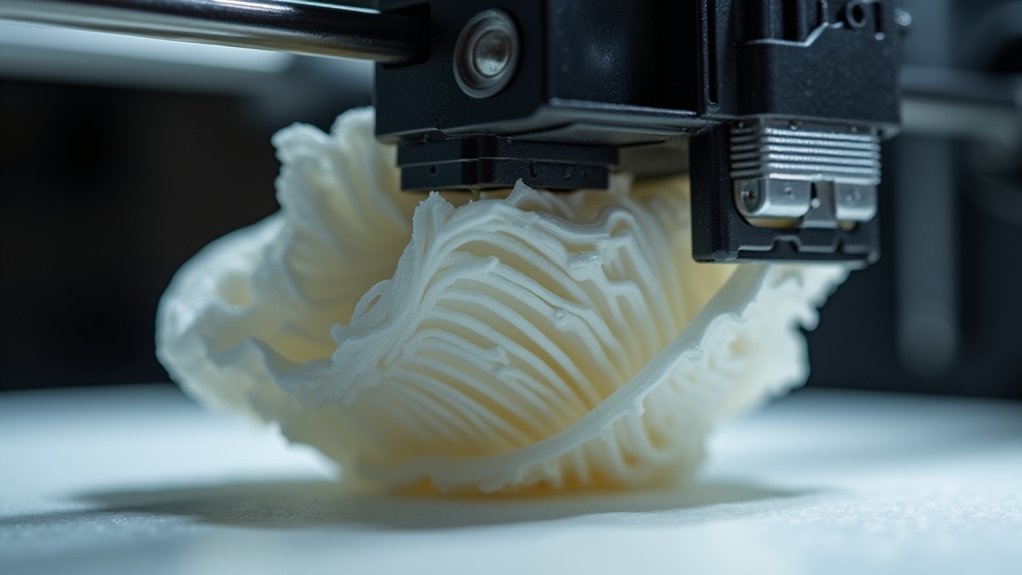
When you’re printing overhangs without sufficient cooling, the extruded filament doesn’t solidify quickly enough to maintain proper layer adhesion.
You’ll notice that gravity starts working against you, pulling down on the still-soft material and causing layers to deform or separate from each other.
This combination of inadequate cooling and gravitational forces creates weak bonds between layers, leading to failures in your unsupported sections.
Insufficient Cooling During Extrusion
Because overhangs lack structural support from below, they’re particularly vulnerable to cooling-related failures that compromise layer adhesion.
When your printer’s cooling system can’t adequately solidify freshly extruded filament, overhangs begin drooping and sagging as the material remains too soft to maintain its intended shape.
Here’s how to optimize cooling for better overhang performance:
- Increase part cooling fan speed to maximum capacity when printing overhangs exceeding 45 degrees.
- Lower your printing temperature to reduce the time filament stays molten and shapeable.
- Monitor cooling parameters continuously, as inadequate cooling creates stringy extrusions and poor surface finishes.
- Adjust fan settings based on overhang angle – steeper angles require more aggressive cooling to prevent structural failures.
Proper cooling transforms challenging overhangs from printing obstacles into achievable features.
Gravity Forces Deform Layers
As gravity pulls downward on freshly extruded filament, unsupported overhangs become vulnerable to deformation that compromises layer adhesion and structural integrity. When you’re printing overhangs without proper support, gravity acts as your primary enemy. The weight of newly deposited material pulls downward before it can solidify, creating weak bonds between layers that haven’t cooled sufficiently.
| Overhang Angle | Deformation Risk | Required Action |
|---|---|---|
| 0-30° | Minimal | Standard settings |
| 30-45° | Moderate | Reduce temperature |
| 45-60° | High | Add supports |
| 60-75° | Severe | Reorient model |
| 75-90° | Critical | Mandatory supports |
You’ll notice longer unsupported spans experience greater gravitational stress, causing the filament to sag and curl. Higher printing temperatures worsen this effect by keeping material pliable longer, preventing proper layer bonding.
Print Speed and Flow Rate Impact on Overhang Quality
While structural supports and cooling fans help manage overhang challenges, your print speed and flow rate settings often determine whether those overhangs succeed or fail.
When you’re printing overhangs, these parameters work together to control material deposition and cooling effectiveness. High speeds don’t give filament enough time to solidify properly, causing sagging and drooping.
Meanwhile, excessive flow rates deposit too much material, overwhelming the layer’s ability to maintain its shape.
Here’s how to optimize these settings:
- Reduce print speed to 30-50 mm/s for overhangs to allow proper cooling and layer bonding
- Lower flow rate to 90-95% of default settings to prevent over-extrusion
- Test speed-flow combinations since incorrect pairings cause print failures
- Monitor each layer’s solidification before the next layer gets deposited
When Support Structures Become Necessary
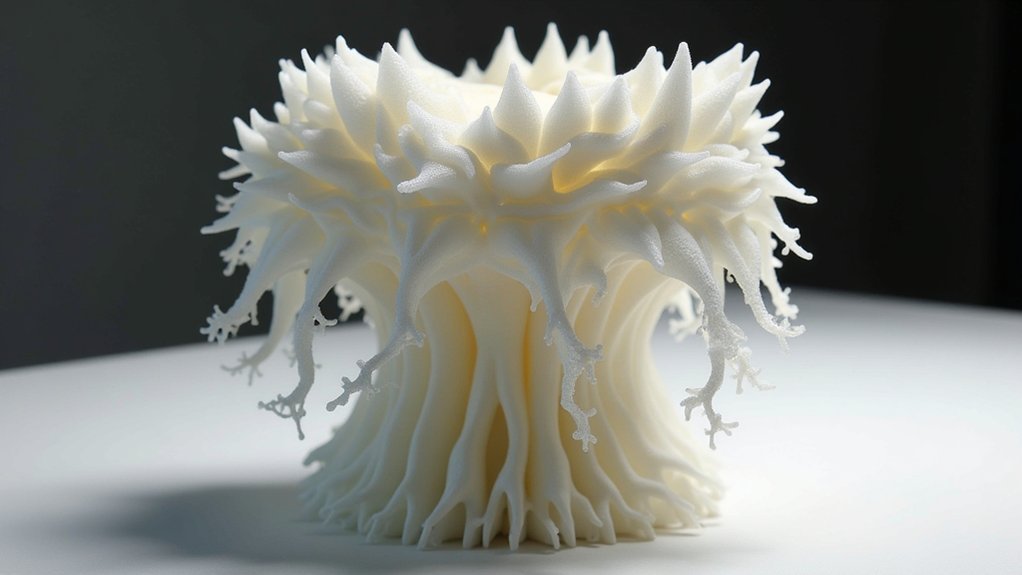
Even with perfectly tuned speed and flow settings, some overhangs will still fail without additional help. You’ll need support structures when overhang angles exceed 45 degrees, as gravity causes sagging or collapse in printed material. Without supports, layers won’t adhere properly, creating stringy or incomplete prints.
| Overhang Type | Angle/Length | Support Needed |
|---|---|---|
| Standard Overhang | >45 degrees | Yes |
| Bridge | <10mm length | No |
| Severe Overhang | >60 degrees | Essential |
Your slicing software can automatically generate supports to prevent print failures and improve finish quality. For intricate designs with severe overhangs, support structures become essential for maintaining shape and preventing drooping. Bridges supported at both ends within 10mm typically don’t require additional support, unlike steep overhangs that need structural assistance.
Frequently Asked Questions
What Is the Reason That 3D Prints Can Fail During a Print?
You’ll face print failures from insufficient cooling, poor bed adhesion, excessive print speeds, steep overhang angles exceeding 45 degrees, and low-quality filaments that don’t extrude consistently during the printing process.
Is It Better to Print Overhangs Fast or Slow?
You should print overhangs slowly. Slower speeds let filament cool and solidify properly, preventing sagging. Fast printing causes stringing and poor layer adhesion, especially on angles exceeding forty-five degrees.
Why Is My 3D Print Overhang Not Sticking?
Your overhang isn’t sticking because you’re likely printing angles steeper than 45°, using insufficient cooling, or printing too fast. Reduce speed to 75%, increase cooling, and add supports for better adhesion.
How to Get Better Overhangs in 3D Printing?
You’ll achieve better overhangs by optimizing print temperature around 220°C, using 0.15-0.2mm layer heights, increasing fan speed for cooling, minimizing overhang angles below 45 degrees, and ensuring you’re using dry, high-quality filament.

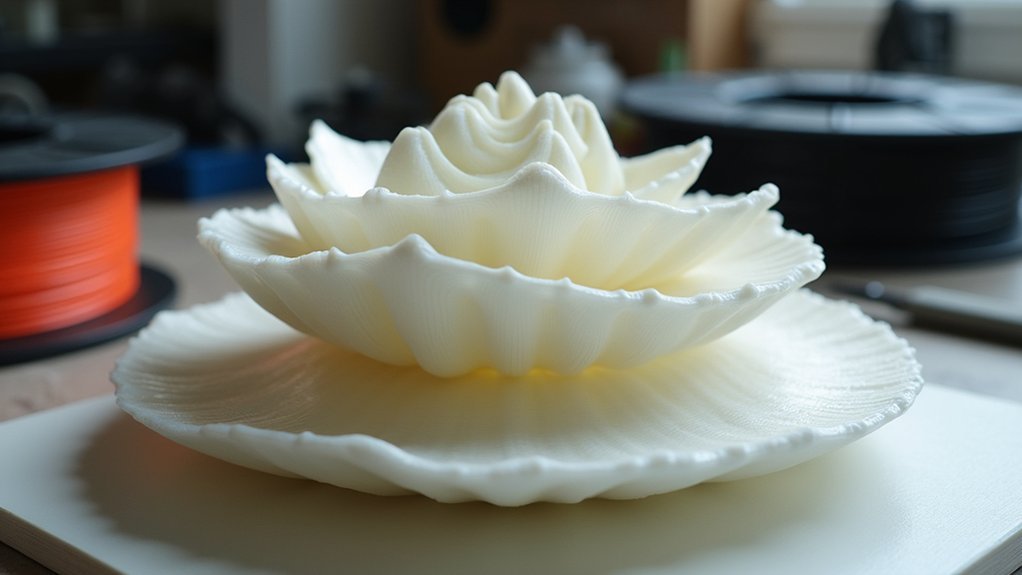


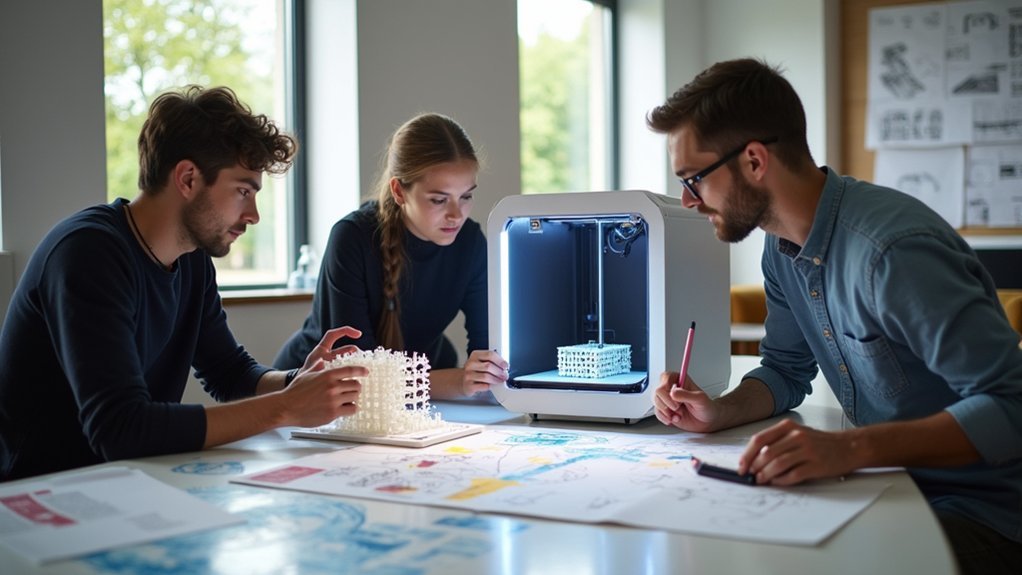
Leave a Reply